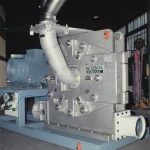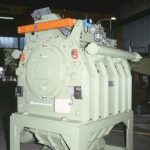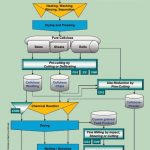The demands placed by the manufacturing industry on the technical design of mechanical plants and processes are getting tougher all the time. Gas-tight or surge pressure-resistant designs are already a must for most plant and machinery to ensure compliance with the latest regulations. New product qualities and/or methods of production also enlarge the portfolio of requirements, for example in the cellulose processing sector.
Thomas Schneider, Wolfgang Rohmann
A whole range of mechanical and chemical process steps are necessary, in order to first of all separate cellulose from the natural attendant materials and then transform it into a chemically pure material. This process results in fibres approximately 1 to 3 mm in length, which after pressing and drying are converted, amongst other things, to roll or sheet material. The most important mechanical handling steps during the production of cellulose and cellulose derivatives are size reduction, fine grinding and classifying.
The first step: pulverisation
In order to be able to use the cellulose for other applications, a further mechanical processing step always has to be carried out: pulverisation. The specially developed Condux CS 500/1000-Z mill is used for this purpose. The feed product is finely milled in this machine by means of a multi-knife rotor (16 cutting edges at the circumference), a large number of fixed cutting knives and a special screen insert. The throughput of the fine-cutting granulator depends on the desired final fineness (usually between 0.1 and 0.5 mm) and the quality of the feed product. With a drive power of 75 kW, product capacities of up to 500 kg/h per machine can be achieved. The outstanding characteristics of this machine, many of which are already operating worldwide, are its low working temperature and the resulting low viscosity loss of the product at high bulk densities of up to 150 g/l.
The processing steps vary according to the feed product. The rolls are guided into the cutting rotor via a nip-roll system. Before they are actually pulverised, the cellulose sheets or baled product are pre-cut by an upstream Condux cutting granulator or a cube dicer to a size of approximately 3 to 20 mm, then transported via a pneumatic conveying system either to an intermediate silo or directly to a fine-cutting granulator. The final product is a cellulose powder with the highest possible bulk density. This powder is commonly used under the name alpha cellulose as a filler and reinforcing material and can even be employed as a substitute for plastic or glass fibres. Cellulose powder is also suitable as a raw material for the manufacture of cellulose derivatives.
Fine milling of cellulose derivatives
Cellulose derivatives destined for technical applications or the food industry, such as cellulose acetate, cellulose ethers or esters, have to undergo further fine milling after the chemical reaction. These derivatives, some of which are available in granule form, are ground down to the desired final fineness by mechanical impact mills. Size reduction on the Condux universal mills is achieved mainly by an impact and shearing action. Screenless designs, e.g. corrugated disc mills, process cellulose derivatives in a single pass. The final size is determined by the peri-pheral speed and the disc gap. A rotating tool acts against a stator as a blast or wing beater mill, whereby this tool can take the form of a screen track, a corrugated milling track or a screen/milling track. This allows repeated mechanical working of the product within the mill. A throughput of approximately 1000 kg/h with a final size of <0.8 mm is thus possible with a CUM 680 universal mill (75 kW).
Screening and classifying
Some derivatives are unsuitable for further use after the milling process due to their particle size distribution. Superfine final prod-ucts are necessary for certain applications. Subsequent treatment is therefore essential in order to achieve precise particle size fractions, and to obtain and optimise the desired characteristics of the product. In this case, the Condux ultra-fine classifier permits classification into very fine particle size ranges. Fine and coarse prod-uct streams can be produced from a feed product stream using a carrier gas and a rotating classifier wheel. The infinitely variable classifier wheel speed, which can be adjusted to give the desired fines quality, ensures a specifiable clean classification of the product. A previously milled cellulose derivative can be classified with an ultra-fine type CFS 510 classifier to separate out the coarse product. The final product is a powder with a particle size of d97 = 200 µm from a feed quantity of 1250 kg/h.
Ideal for explosive compounds
Various combustible and explosive compounds, known as nitrocelluloses (NC), are formed due to the esterification of cellulose with nitric acid and sulphuric acid. A special kind of mechanical processing is required for the acid nitration necessary for this purpose, in order to defibrate the cellulose as far as possible. This can be carried out using a Condux hammer mill. The central part of this machine is a rotor equipped with flat steel beaters. The wound product, which is fed continuously into the machine via a special nip-roll system, is guided above the beater system, taken up by the rotating beaters and thrown against the grinding tracks and screens or cleaver grid. A throughput of 1000 kg/h can be achieved using a CHM 1000/1200-L1-EV hammer mill with a driving power of 90 kW, a rotor diameter of 1000 mm and a working width of 1200 mm. Pinholes and knots can be continuously homogenised and eliminated by a Condux CHZM 10/100/N4 horizontal tooth disc mixer. The previously defibrated cellulose is continuously moistened by adding a mixture of water and acid. This is achieved by friction and shearing between a fixed and a rotating toothed milling disc. Adjustments can be made by changing the gap between the two grinding discs. Approximately 1100 kg per hour of dry mass can be processed with an installed driving power of 90 kW.
cpp 431
Powtech 2005
More information on the mills
Condux laboratory machines
Bulk-Online
Share:









